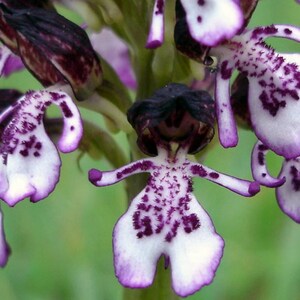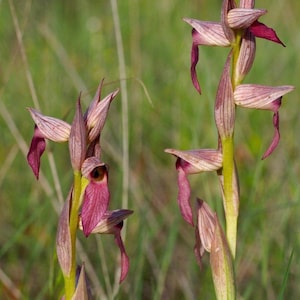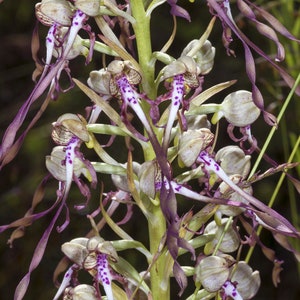









Orchid
orchid Serapias vomeracea bulb or seed pod and substrate. long-lipped serapias, ground orchid.
$6.76
-
DetailsWe ship with DHL Express for international shipping, which is extremely fast arriving in a few days! so your plants arrive in perfect condition :) Our flat rate for express shipping is 22 euros, so we encourage you to buy a selection of our products (plants, moss, substrates) as we do free shipping worldwide after 100 euros of items are bought with coupon FREESHIPPING100.
If you are experiencing any problems during checkout please contact me and we can sort it out. (ie. item it is not available for your area).
Our bulbs are grown in red clay on our farm. We package them in moss for safe travels to you.
Our seed pods are harvested at just the right time while still closed yet ripe. We dehydrate them at 35 degrees and put the in plastic seed containers for the perfect condition until use.
We sell the red clay substrate 100g which we recommend using, and a sheet of moss which we recommend place on top of the substrate once the seeds are sown.
We also recommend buying one 2 year bulb o grow in the same substrate as the seeds, success of germination is significantly higher when a bulb is grown near them, a 2 year old bulb is sufficient, this is because of a relationship with mycorrhizal fungus.
How to sow: mix the red clay substrate with potting soil - in a seeding tray 7-10cm thick, water substrate then compact it with your fist. Take the seed pod and crushed it slightly, a fine dust of seeds will come out, once the seeds are out do not touch them. Cover with the moss sheet, then water gently, the water will disperse the seeds more.
Place the tray in the fridge for 12 weeks for a chilling time.
Take the tray out and place in partial shade spray with water once a week.
germination in 8 or 11 months
The success of germination is significantly higher when a bulb is grown near them, a 2 year old bulb is sufficient, this is because of a relationship with mycorrhizal fungus.
Serapias vomeracea, common name long-lipped serapias or the plow-share serapias, is a species of orchid in the genus Serapias.
The name Serapias of the genus derives from the Greek Sarapis, the Graeco-Egyptian god, already used in ancient times to name some orchids. The Latin name vomeracea of this species refers to the shape of the apical portion of the labellum (epichile) reminiscent of the ploughshare of a plough.
Serapias vomeracea is an herbaceous perennial plant with two ovoidal underground tubers. This species is highly variable in color and shape. It reaches a height of 20–40 centimetres (7.9–15.7 in), with a maximum of 60 centimetres (24 in). The stem is green, with two membranous basal leaves and 6-8 upper leaves, lanceolate and glossy green or reddish.
The inflorescence is composed by a narrow and elongated spike, with three to ten flowers. The relevant bracts are lanceolate and much longer than the tepals. Their color is red-purple, with darker longitudinal venation. The outer tepals are lanceolate and erect, forming an helmet-like structure. Their color is purple-red or pinkish, with veins of darker color. The internal lateral tepals are brownish-purple and almost entirely hidden by the helmet.
The labellum is brick red, trilobed and larger than the other tepals. The basal portion (hypochile) of the labellum is concave and enclosed in the helmet, with two raised and hairy lateral lobes. The apical portion of the labellum (epichile) is triangular-lanceolate, usually purple-red and quite hairy. The spur is missing. The flowering period extends from March to June.
Serapias vomeracea is an entomophilous plant, but cannot offer floral rewards to pollinators, as it does not produce nectar. Therefore, this orchid has a deceptive strategy, as pollinators are just attracted by the shape of the flower, forming a small tube used by insects to rest by night or as a refuge against the rain. In this process the pollen stuck to the pollinators bodies. Once they leave their shelter, they will deposit the pollen on other flowers and will fertilize them. These orchids are mainly pollinated by some beetles (families Oedemeridae and Lymexylidae) and by bees (genera Ceratina, Eucera and Osmia). The dispersal of seeds is granted by the wind (anemochory).
The species has a Mediterranean- Atlantic distribution from Charente in the north and is widespread from south-central Europe, the Mediterranean Basin to Cyprus.
This orchid prefers dry and wet meadows, pastures, thickets, clearings and scrubland, frequently on clayey substrate, from full light to partial shade, at an altitude of 0–1,200 metres (0–3,937 ft) above sea level. -
Shipping & Policies
Shipping from France
Processing time
1-2 business days
Customs and import taxes
Buyers are responsible for any customs and import taxes that may apply. I'm not responsible for delays due to customs.
Payment Options
Returns & Exchanges
I gladly accept returns, exchanges, and cancellations
Just contact me within: 14 days of delivery
Ship items back to me within: 30 days of delivery
- Custom or personalized orders
- Perishable products (like food or flowers)
- Digital downloads
- Intimate items (for health/hygiene reasons)
- Items on sale
Conditions of return
Buyers are responsible for return shipping costs. If the item is not returned in its original condition, the buyer is responsible for any loss in value.
Questions about your order?
Please contact me if you have any problems with your order.



